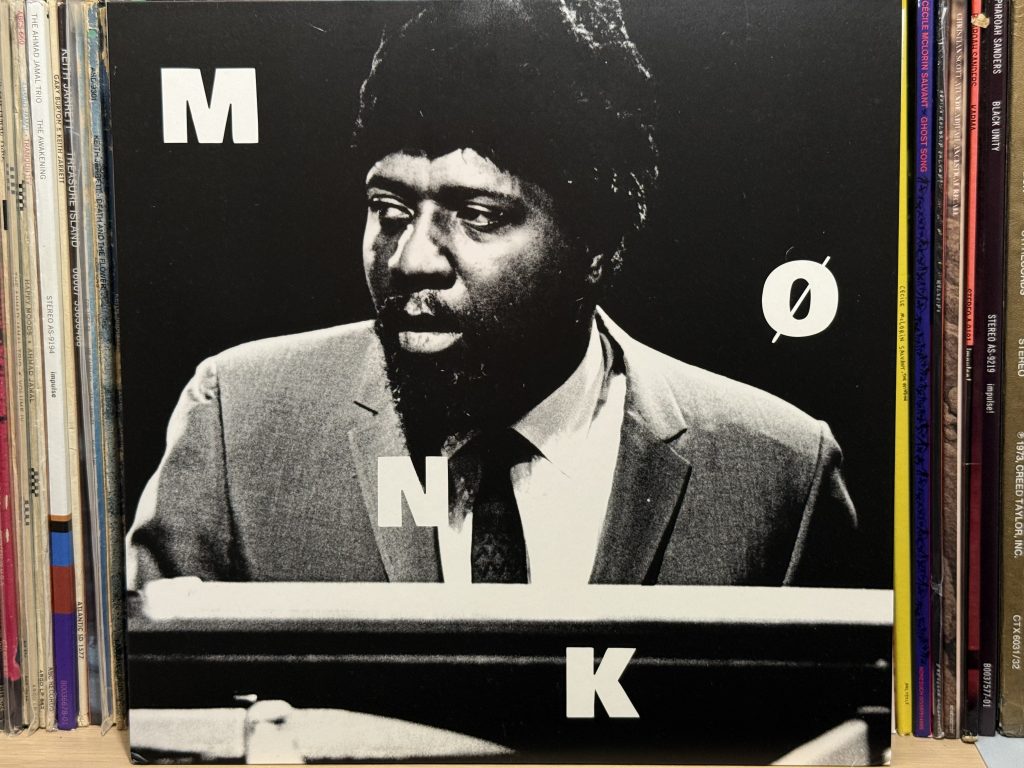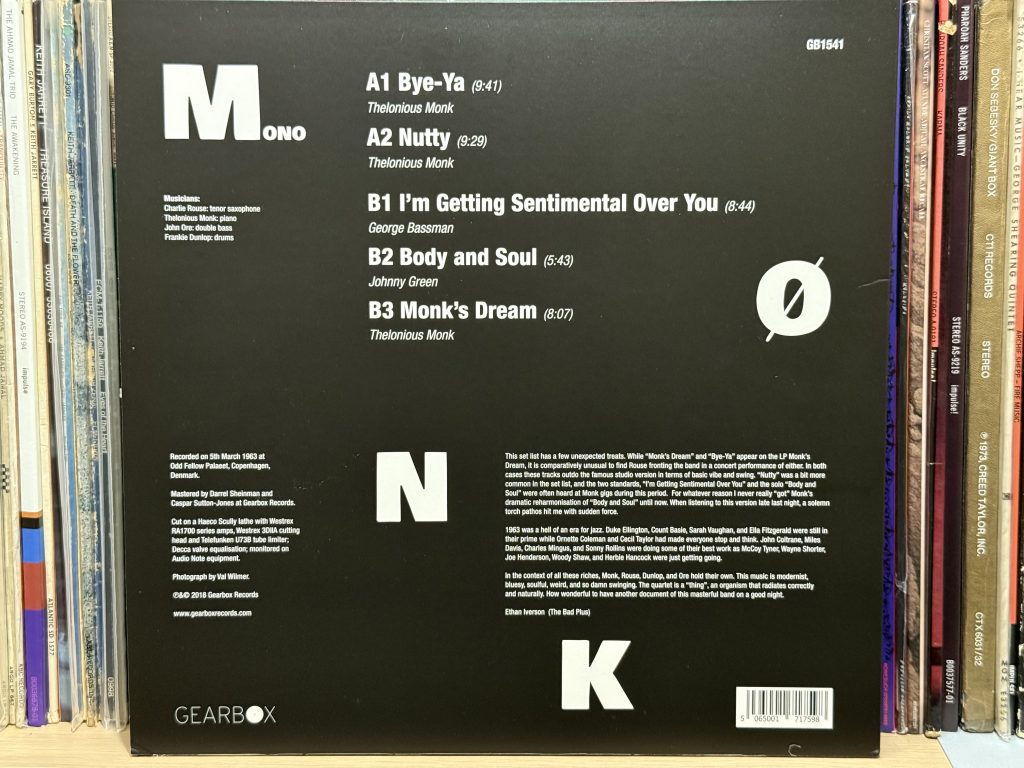
Album of the Week, July 26, 2025
Thelonious Monk recorded his final record for Columbia, Underground, in 1968, following several live albums and Solo Monk. While the record featured a number of new compositions, it marked an end rather than a revitalization. By the early 1970s, Monk was done, having made a handful of recordings on smaller labels. He retired for health reasons, having been diagnosed with psychiatric disorders and prescribed medications that made him uncommunicative.1 He spent the last six years of his life as a guest of the Baroness Pannonica de Koenigswarter, dying of a stroke in 1982. So his would seem an unlikely wellspring in which to find a source of new recordings.
But, just as new Coltrane tapes have been turning up in odd places, so a few significant Monk recordings have surfaced in the last few years. An improbable session booked by a 16-year-old high school student and taped by the high school’s janitor, Palo Alto captured the final known performance of Monk’s last quartet with Charlie Rouse, Larry Gales and Ben Riley. And a 1963 live recording from the Odd Fellows Palaeet in Copenhagen surfaced on tapes rescued from a dumpster yields today’s album, a rare live document of his greatest quartet with Rouse, bassist John Ore, and drummer Frankie Dunlop. Together they had recorded two great sessions for Columbia; they were in the middle of sessions for Criss-Cross at the time of this concert, but Monk’s Dream had just been released, so three of the tracks come from those sessions.
“Bye-Ya,” one of the Monk’s Dream tracks, had a long simmer in Monk’s book of compositions, having been recorded for Prestige on Thelonious Monk Trio in 1952. The tune is a 32-bar Latin tune, originally titled “Go”; when producer Bob Weinstock wanted a name with more of a Latin feel, Monk literally translated it, called it “Vaya,” which became “Bye-Ya” in his inimitable dialect. The performance here starts out with a syncopated explosion from Dunlop, who had previously recorded with Sonny Stitt, Sonny Rollins, and Duke Ellington, among others. Monk enters on a two note pattern while Rouse states the melody, and then we’re off to the races with a brilliant contrafact from the saxophonist over two verses. Despite his reputation for eccentricity, Monk is tight here with the rhythm section, the whole unit performing with a snap and flair. There’s no sense of the mountain-climbing hard labor that characterized Brilliant Corners; Rouse, Dunlop and Ore knew this material like the backs of their hands, so they provide a sense of ease and delight as they stretch out through the material. Monk’s own soloing is similarly relaxed and joyous, at one point embracing an off-the-beat series of staccato exclamations that fit naturally with the rest of the tune.
“Nutty” also originated on Thelonious Monk Trio and had last been recorded on Thelonious Monk with John Coltrane in 1957, but was a staple of Monk’s live sets. Monk opens with a jaunty statement of the melody, and then Rouse is off to the races, playing brisk double-time runs over bursts of chords from Monk and a constant support from Ore and Dunlop. The bassist, who would go on to play with Sun Ra, gives a dry walking bass that touches the corners of Monk’s unusual chords and then walks off into other neighboring dimensions, all while keeping things tightly anchored. Monk’s solo breaks apart the bits of the tune; he finds a five-note pattern and holds onto it, repeating it four times against the changing chords. The last of his solo is sketched in bare chords that leave most of each measure open, allowing Ore’s bass and the pops and booms of Dunlop’s drums to show through.
While his own tunes show little of the stride piano that tinges his playing of Ellington and his later performance on Solo Monk, it raises its head on “I’m Getting Sentimental Over You”; presumably he reserved the technique for the compositions of others, like this 1932 tune written for Tommy Dorsey by George Bassman and Ned Washington. There’s very little sentimentality in Rouse’s solo, which takes off at high speed and gives us a briskly virtuosic tour through the corners of the tune. Monk’s solo eases off on the Fats Waller influence, giving a more modern be-bop take on the tune, complete with a descending line that sounds rather like someone coming down the stairs sideways.
The great classic “Body and Soul,” also appearing on Monk’s Dream, here gets a rubato solo take by Monk that plays some chordal adjacencies and re-voicings, as well as some of the chromatic vamps that make for some of the most distinctive Monk sounds in his own compositions. The subsequent verses are done in strict time, though some of Monk’s improvisations play against the beat in a way that threaten to unravel the momentum. Just as one begins to fear that we’re stuck in the offbeat eternally, Monk clicks the melody back into time, rewarding the listener with a breathtaking glissando. It’s a fine performance that would have shone on Solo Monk.
“Monk’s Dream” headlines the album of the same name, but its origins also go back to Thelonious Monk Trio. The chord progression threatens to make the listener’s ears cross-eyed, as it were, but the quartet makes it sound easy, with brisk rolls from Dunlop punctuating each phrase of the song. Monk plays a series of leading tones under Rouse, leading to a feeling of instability in the tune and a feeling that Rouse is about to come unmoored and play away into some other song. But as they continue to play the connection reiterates itself and the wooziness is revealed to be deliberate. Rouse plays the last verse of his solo without Monk; without the chords it’s easier to hear Rouse’s conception of the melody. When Monk returns, he brings back the leading tone patterns and then slowly builds a solo around them, exploring outward chromatically, anchoring one entire verse of the solo a defiant tone away from the tonic. Indeed, the performance might serve as a sort of Rosetta Stone to his overall conception of melody, as he digs into everything but the tonic, finding joy in the adjacencies of tone.

Mønk is part of a wave of newly discovered jazz tapes that threaten to swamp the listener in an embarrassment of riches—and might seem to threaten the efforts of newer players. After all, why seek out the recordings of a Tyshawn Sorey or Linda May Han Oh when another lost recording from Coltrane, Monk or Bill Evans beckons? The answer, of course, is “¿Porque no los dos?” And there’s some truly fantastic material being recorded today (though not often being released on vinyl, which limits how much of it I’ll write about in this series). Next week we’ll start listening to different performers on the same (groovy) instrument in recordings that stretch from
You can listen to this week’s album here:
BONUS: 1963 was busy for Monk and his quartet. A less pristine tape capturing a performance in Stockholm by the group was released as the bootleg Live in Stockholm 1963, and it’s worth a listen as well.
- This may have contributed to some of Monk’s reputation for eccentricity. Or it could just have been his style. The saxophonist Charles Lloyd, who was up and coming in the late 1960s, tells a story about being on tour with Monk in which the great man danced around Lloyd’s dressing room between sets and, despite a plea from Pannonica, drank an entire pitcher of orange juice because Lloyd told him it was “tainted.” ↩︎
